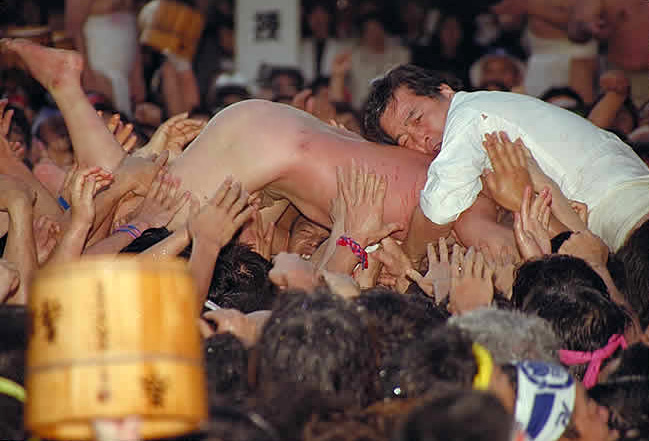 |
||||||
|
||||||
Konomiya Naked Festival
(Konomiya Hadaka Matsuri)
January 13 of the lunar calendar
Kounomiya Shrine
One of the most famous naked festivals in Japan and attracts approx. 200,000
to 300,000 spectators in each year.
 |
||||||
|
||||||
| Schedule |
Naoi-shinji, also known as "Hadaka Matsuri (naked festival) ",
started in the year 767A.D, the Nara Period.
This rite was founded on the fact that the governor of
Owari Province (presently Aichi Pref.)
visited the Owari Shosha Shrine ( Konomiya shrine )
to drive away evil spirits and calamities, because Emperor Shotoku
ordered all the kokubun-ji* to offer invocations to dispel plagues.
It is said that the form of the festival, a struggle to touch the Naoinin or Shin-otoko (man of god),
is reminiscent of the struggle in old times between the assemblage of lower-ranking
shinto priests called shanin and
contributors tried to catch and set up a man for naoinin (shin-otoko),
an unlucky poor man, who was unwilling to take the role.
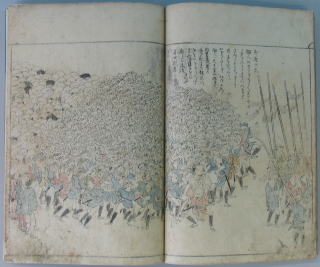  |
| Catch a naoinin (present shin-otoko) |
| Click for larger pictures(You see a naoinin in a white kimono on the right page of the left book.) |
| *These pictures are taken out of "Owari-Kokufu-Saiki"/ collection of Nishio-shi Iwase-bunko librely. *Please don't copy these pictures from this webpage directly. *If you would like to copy them, please contact Nishio-shi Iwase-bunko |
 |
 |
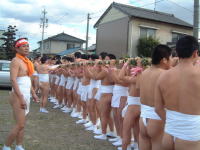 |
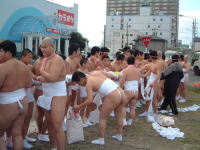 |
 |
|
| Making of naoizasa | |||
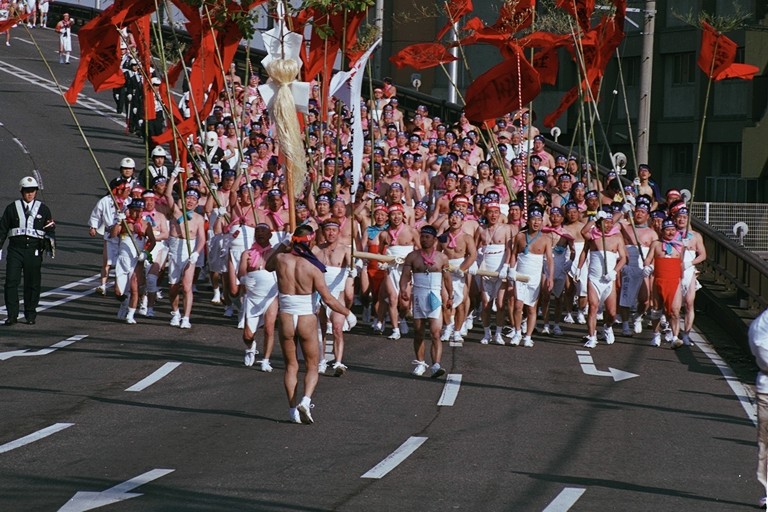 |
||
|
On the way to the shrine, they swing and turn around and sometimes
climb up a naoizasa pole.
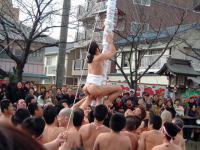 |
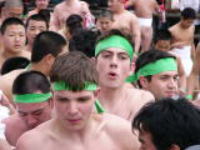 |
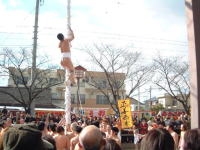 |
| Click above for a larger picture | Climb high, climb far ! | |
After they have carried the bamboo to the shrine, they wait for the appearance
of Shin-otoko.
No one knows when he will appear, but it is usually around 4:30 to 5:00
p.m.
On that day, the Shin-otoko is completely naked.
He is guarded by very tough ex-shin-otokos, because hundreds of naked men
surround him and try to touch him to get rid of misfortune for the new
year.
The Shin-otoko appears from the path in front of the shrine,
but it takes him more than 30 -40 minutes to reach the shrine
because of the huge crowd of naked men.
Cold water is showered over them again and again to scatter them away from
Shin-otoko,
and also to protect the naked men from being hurt by the violence of the
crowd.
Since this festival is held in a very cold season, water quickly
becomes steam moments after it is thrown.(Look at the picture on the top
of this page).
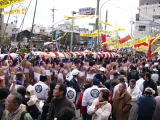 |
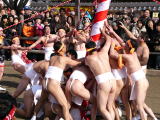 |
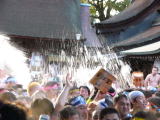 |
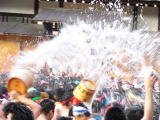 |
| Click above for a larger picture | . | ||
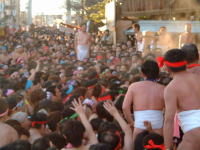 |
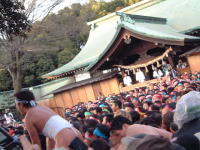 |
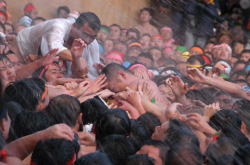 |
| Click above for larger pic..photo by Takeken |
The ages of 23 and 42 for men are "yaku-doshi" or the age of suffering from misfortune.
So, lots of people who are 23 and 42 years old participate in this festival
to touch Shin-otoko in order to get rid of their misfortune.
Of course any men can be "naked men (hadaka-otoko)" in this festival.
One day before the festival, between 1:00p.m. and 2:00 p.m.,
a set of huge rice cakes called O-kagamimochi (weighing 4 tons) are carried to Kounomiya Shrine.
One is 2.4m and the other is 2m in diameter and
the smaller one will be put on the bigger one.
The following day of the festival, the rice cake will be cut and given
to the people.
If you have pieces of this rice cake, you will have good health during
the summer.
You will probably be able to get it a few days after the festival.
| This is a part of headband that the real naked man wore ! |
| Schedule of the Naoi-shinji or Naked Festival | |||
| 2023 | Old Calendar | time | ceremony |
| Jan.23 | January 2 of the lunar calendar |
9:00 | Pillar Raising Ceremony (儺追神事標柱建式/shimebashira tateshiki ) |
| 10:00 | Naoinin or shin-otoko Selection Ceremony (儺負人選定式/naoinin or shin-otoko senteishiki ) |
||
| Jan. 27 | January 6 of the lunar calendar |
10:00 | Washing rice for the 4-ton huge rice cake (大鏡餅餅米洗/O-kagamimochi kome-arai ) |
| Jan.28 | January 7 of the lunar calendar |
5:00 | Making of ancient mirror -shaped rice cakes (大鏡餅餅搗/O-kagamimochi mochitsuki ) |
| 9:00 | Kuwagata Festival (鍬形祭/Kuwagatasai) |
||
| Jan.31 | January 10 of the lunar calendar |
17:00 | Naoinin (Shin-otoko) comes to stay in the shrine (儺負人参籠/naoinin sanroh ) |
| Feb. 1 | January 11 of the lunar calendar |
9:00 | Decorating the huge rice cake |
Tsuchimochitsuki-shinji and hifu-shitatame |
|||
| Feb. 2 | January 12 of the lunar calendar |
13:00 | Offering of the 4-ton huge rice cakes |
| 19:00 | Choya-shinji |
||
| Feb. 3 | January 13 of the lunar calendar |
15:00 | |
| Feb.4 | January 14 of the lunar calendar |
3:00 | Yo-Naoi-Shinji.....Night Naked Festival (This ritual has a history of more than 1200 years) |
| 8:00 | Cutting and distribution of the huge rice cakes |
||
| Feb. 7 | January 17 of the lunar calendar |
19:00 | Matoi-shinji |
| Feb. 12 | January 20 of the lunar calenda |
9:30 | Naoi Chakai Japanese tea ceremony party |
![]()
2023 ?
Let's participate the Naked Festival !
If you would like to participate in this festival as a naked man/hadaka-otoko,
| Please contact me via e-mail subject: konomiya |
|
Application deadline of Sarashikai group: January 26, 2020
Expence
* Participation fee: 2,500yen (student: 2,000 yen) in 2019 <Not yet
decided for 2020>.
* Special matsuri-tabi (Japanese socks with rubber sole for festival) : around 1,000yen
* Sarashi (bleached cotton cloth): around 1000 yen
* Sake and snacks (share the expenses with international participants)
300 yen to 500yen
*Transportation fee *Lunch
I will buy your tabi and sarashi in advance if you don't know where to
buy them.
Please let me know your shoe size in advance.
Details to participate
![]()
Konomiya Shrine
1-1-1 Konomiya, Inazawa city
TEL: 0587-23-2121
<access>
* Take Meitetsu Nagoya Honsen line bound for Gifu from Meitetsu Nagoya
Sta.
(Platform No.1)
Get off at Konomiya sta.
(about 13 min from Meitetsu Nagoya Sta. by express)
3-min. walk
360 yen (one way)
![]()
Festivals around Nagoya
Festivals in Nagoya
Festivals in Japan
![]()
![]()